So if I go with the trichlor pucks, it is just trial and error to figure out the effect of adding since they take time to dissolve? If I look at the Mega Tabs from Leslies, each puck is 28oz, and according to Pool Math, that will raise FC 7.1 & CYA 4.3, and lower pH by 0.4, but that would be over the entire time it takes to dissolve, which may be like a week. So could I assume, that if it takes 7 days to dissolve, that I can divide those numbers by 7 to get an approx daily effect? Based on your response, I would still be adding liquid chlorine, but the use of a puck would help keep my FC consistent enough to avoid algae, so if this is correct, then I would need some way to figure out how much chlorine to add daily if I am using a puck and need to keep FC at the 2-3 range.
Yellow stains on liner
- Thread starter cholmes28
- Start date
You are using an out of date browser. It may not display this or other websites correctly.
You should upgrade or use an alternative browser.
You should upgrade or use an alternative browser.
I agree, Andy. TFP methods are based on some solid, often complex science but our application of these methods needs to be easy enough for virtually all of us to practice them.It just seems like we are getting too technical here with chemicals and are getting away from the basics. Thoughts?
Here is what I have in my skimmer right now. Lightly but completely stuffed with polyfill and a trichlor puck sitting on top. The trichlor usually dissolves over a day or two and in theory, it makes the water higher with FC right as it flows through the polyfill.
I still have the solar cover on right now so there isn't too much debris getting into the skimmer. I just test my water as normal and dose bleach as needed. I will stop using the poly fill in the skimmer once I stop using solar cover for the summer.
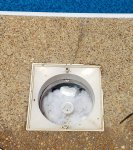
I still have the solar cover on right now so there isn't too much debris getting into the skimmer. I just test my water as normal and dose bleach as needed. I will stop using the poly fill in the skimmer once I stop using solar cover for the summer.

Just of note, I don't normally keep trichlor pucks in my skimmer because I know they are acidic but that doesn't matter on top of the polyfill that I'm just going to throw away. I do use trichlor pucks in my feeder throughout the summer on the lowest setting as supplemental FC but do all my testing and dosing using bleach as my main source.
Also, since the trichlor pucks are acidic, this may defeat the purpose of the higher FC right as it goes over the polyfill to absorb iron but is worth a try. Either way I have the polyfill in my skimmer to get as much water flowing through it as possible.
Also, since the trichlor pucks are acidic, this may defeat the purpose of the higher FC right as it goes over the polyfill to absorb iron but is worth a try. Either way I have the polyfill in my skimmer to get as much water flowing through it as possible.
- May 23, 2015
- 25,708
- Pool Size
- 16000
- Surface
- Plaster
- Chlorine
- Salt Water Generator
- SWG Type
- Pentair Intellichlor IC-60
While I am not going to be able to explain all the chemistry like you all can, where is the step for removing the iron? I know I personally wouldn't be able to sustain the precise chemical levels discussed here and the iron still remains for potential staining. This will take time but shouldn't a lot of the iron be absorbed over a few weeks with the FC causing the iron to precipitate to the polyfill strands? Isn't that the science behind the polyfill? The tiny strands create more surface area to precipitate and will have much more water flow than the rest of the pool surfaces?
Even if the incoming water is going to have some iron in it, wouldn't it still have a lot less iron than the current water in the pool? A water exchange immediately after AA treatment seems to be a lot less expensive than all these chemicals. Diluting the iron in the pool will also require less sequestrant and polyfill to get the job done. Wouldn't the phosphates also be diluted with the incoming tap water?
It just seems like we are getting too technical here with chemicals and are getting away from the basics. Thoughts?
There are many strategies for iron control and a lot of it depends on the source of the iron stains. If the fill water being used has lots of iron in it, then using polyfill doesn't help as there is just a constant source of iron being added to the pool. In my experience with posts on this forum, polyfill seems to work best in smaller above ground pools that are kept covered to reduce evaporation. With an in-ground pool and fill water that is high in iron, the polyfill will just never keep up. If a pool owner has to switch to chemical methods of control, then lowering pH and FC is essential and that then requires the other methods of algae control that were suggested. Unfortunately, pool water with high iron levels is not easy to deal with.
That said, if the OP would like to try using polyfill in the skimmer, they are certainly welcome. But the polyfill will not work until all sequestering agents are gone and the iron is allowed to precipitate out of solution. That can result in tea-brown/clear-green water for a while...
- May 23, 2015
- 25,708
- Pool Size
- 16000
- Surface
- Plaster
- Chlorine
- Salt Water Generator
- SWG Type
- Pentair Intellichlor IC-60
Here is what I have in my skimmer right now. Lightly but completely stuffed with polyfill and a trichlor puck sitting on top. The trichlor usually dissolves over a day or two and in theory, it makes the water higher with FC right as it flows through the polyfill.
I still have the solar cover on right now so there isn't too much debris getting into the skimmer. I just test my water as normal and dose bleach as needed. I will stop using the poly fill in the skimmer once I stop using solar cover for the summer.
View attachment 140590
That's not the correct implementation. You do not, and should not, use trichlor pucks with polyfill. Trichlor pucks are acidic and the acidity is enough to keep the iron suspended in solution where it will pass right through the polyfill. The chlorine levels will not get high enough to overcome the deep decrease in pH and so iron will not precipitate. If you wish to use that method, then you need to use a cal-hypo puck, not a trichlor puck. Cal-hypo both raises pH AND FC which results in scaling.
I would remove that trichlor puck, the low pH water running through your pool equipment is not good for it.
Who knew that my post would get so much attention. I really appreciate all the input. As Andy pointed out, all of what I have tried thus far with the multiple AA treatments, eliminator kits, poly fill, socks over the return jets, etc are all just band aids to keep stains from presenting themselves. If I could just get to the point of the stains not showing for a couple weeks, then I am fine dropping a qt of metal-free in every month but I can’t get past day 4.
The real problem is how the iron got into the water in the first place. I have had this pool for 9 years, and this is the first time I have had this issue. I use hose water maybe once per year and that is only in mid to late summer if we have not gotten rain in a while. I find myself having to get rid of water way more frequently than adding. I have been following TFP methods since 2014 and other than having to SLAM twice a season due to mustard algae have had no other issues.
I am still not completely clear on where exactly Joyful’s advice lead me in terms of keeping the stain from reappearing and if I need to continue maintenance doses of metal-free, at what frequency is needed since so far the stains reappear after day 3-4 of any process I follow.
My next experiment will be to do a Water exchange in 1/3 increments and see if that helps. Ugh!
The real problem is how the iron got into the water in the first place. I have had this pool for 9 years, and this is the first time I have had this issue. I use hose water maybe once per year and that is only in mid to late summer if we have not gotten rain in a while. I find myself having to get rid of water way more frequently than adding. I have been following TFP methods since 2014 and other than having to SLAM twice a season due to mustard algae have had no other issues.
I am still not completely clear on where exactly Joyful’s advice lead me in terms of keeping the stain from reappearing and if I need to continue maintenance doses of metal-free, at what frequency is needed since so far the stains reappear after day 3-4 of any process I follow.
My next experiment will be to do a Water exchange in 1/3 increments and see if that helps. Ugh!
- May 23, 2015
- 25,708
- Pool Size
- 16000
- Surface
- Plaster
- Chlorine
- Salt Water Generator
- SWG Type
- Pentair Intellichlor IC-60
Low FC + Low pH + Sequestrant use = lower probability of having stains appear.
Low FC = increased chances of getting an algae bloom
In order prevent stains AND reduce the risk of getting algae, you need to supplement the chlorine in some way because, unlike a pool with no metals dissolved in the water, raising FC in your pool will cause the stains to reappear.
You can certainly try water exchanges but you have take out pool water and add in fresh water that has no metals in it. Are you absolutely certain the water you fill the pool up with from your hose had no metals in it?
Low FC = increased chances of getting an algae bloom
In order prevent stains AND reduce the risk of getting algae, you need to supplement the chlorine in some way because, unlike a pool with no metals dissolved in the water, raising FC in your pool will cause the stains to reappear.
You can certainly try water exchanges but you have take out pool water and add in fresh water that has no metals in it. Are you absolutely certain the water you fill the pool up with from your hose had no metals in it?
For 3 days water was super clear, and this morning I noticed that the staining is starting to come back. I have been meticulous about brushing and testing several times per day and trying to keep FC at 3, which is taking a fair amount of chlorine. Day 1 - 150oz, Day 2 - 215oz, Day 3 - 430oz.
Last night I added a qt of Seaklear phosphate remover and this morning my pH increased 7.2 to 7.4. is this due to the phosphate remover and will it come down, or do I need to add a bit of muriatic acid to bring it down to 7.2?
so I guess after $700 spent, it looks like my only other option is a water exchange. Which raises several questions. Do I have to do it all at once? If I do it in half’s or thirds, will the iron left in the water until I do the next exchange just muck up the clean water I put in or will it just continue to dilute until it is manageable?
Last night I added a qt of Seaklear phosphate remover and this morning my pH increased 7.2 to 7.4. is this due to the phosphate remover and will it come down, or do I need to add a bit of muriatic acid to bring it down to 7.2?
so I guess after $700 spent, it looks like my only other option is a water exchange. Which raises several questions. Do I have to do it all at once? If I do it in half’s or thirds, will the iron left in the water until I do the next exchange just muck up the clean water I put in or will it just continue to dilute until it is manageable?
Last edited:
Water exchange right after AA has been the only thing to make a major difference for me. I don't think 30% is going to make the impact you are looking for and seeing how fast your stains are returning, I would shoot for 75% or more. Adding water after pumping it out is just diluting so do it all at once and us a tarp or plastic sheeting to slow down the mixing. Your new water will have less iron in it so you should follow similar procedures with low FC/ph for a while but also a plan to remove a good bit of iron. Give the filter a good backwash with the AA treated water for 30 minutes.
You could also just live with the stains this year and do your AA treatment in February when the water is cold. Not the answer you wanted but the best time to do it to reduce algae.
You could also just live with the stains this year and do your AA treatment in February when the water is cold. Not the answer you wanted but the best time to do it to reduce algae.
I removed the puck. Makes sense about the ph and I thought this may be the case when I put it in. I was willing to give it a try.I would remove that trichlor puck, the low pH water running through your pool equipment is not good for it.
Well, I have to admit that you guys were probably right about the whole Iron Bacteria issue. My stains are starting to return again. I called the CuLator folks, and they asked me to send them a water sample for testing, and I will let you know what they say.
One other question - what would cause my pH to keep going up? I have been trying to keep it at 7.2, and in it seems like every 3-4 days, it creeps up to 7.4 or 7.6. I have added around 150oz of 31.45% muriatic acid in total over the past 3 weeks. Yesterday it was 7.2, and today it was back up to 7.4.
One other question - what would cause my pH to keep going up? I have been trying to keep it at 7.2, and in it seems like every 3-4 days, it creeps up to 7.4 or 7.6. I have added around 150oz of 31.45% muriatic acid in total over the past 3 weeks. Yesterday it was 7.2, and today it was back up to 7.4.
- May 23, 2015
- 25,708
- Pool Size
- 16000
- Surface
- Plaster
- Chlorine
- Salt Water Generator
- SWG Type
- Pentair Intellichlor IC-60
What’s your TA?
Most pool water is way over-carbonated (carbonate is the primary component of TA) relative to atmosphere and so the constant outgassing of CO2 raises pH. The lower you go on pH, the faster the rate of pH rise will be. You should keep your pH no lower than 7.6 and only add acid when it goes above 7.8. Typically if you follow that guidance and keep your TA at or below 80ppm, then the pH will be very stable.
Most pool water is way over-carbonated (carbonate is the primary component of TA) relative to atmosphere and so the constant outgassing of CO2 raises pH. The lower you go on pH, the faster the rate of pH rise will be. You should keep your pH no lower than 7.6 and only add acid when it goes above 7.8. Typically if you follow that guidance and keep your TA at or below 80ppm, then the pH will be very stable.
My TA has been stable at 80 until I added the SeaKlear a few days ago, and it dropped to 70, where it has been since. Regarding keeping pH at 7.6, your previous post suggested I keep it at 7.2, and keep my target FC on the lower end of 2-3, CYA is 35.
- May 23, 2015
- 25,708
- Pool Size
- 16000
- Surface
- Plaster
- Chlorine
- Salt Water Generator
- SWG Type
- Pentair Intellichlor IC-60
My TA has been stable at 80 until I added the SeaKlear a few days ago, and it dropped to 70, where it has been since. Regarding keeping pH at 7.6, your previous post suggested I keep it at 7.2, and keep my target FC on the lower end of 2-3, CYA is 35.
Right. So if you did not have any metal issues, the 7.6-7.8 pH range works well for the majority of pools out there. The reason being is that, above a pH of 7.5, the outgassing of CO2 from pool water drops dramatically and so pH rise slows down a lot. So if a pool owner can lower their TA (that’s the source of carbon dioxide in your water) and if they can keep their pH on the high side (that’s the driving force that converts carbon dioxide to bicarbonate), then pH can be stabilized.
In your situation you have metals in Your water and they tend to stay dissolved if the pH is low. But low pH = lots of dissolved CO2 = fast pH rise. So your basically fighting again at Mother Nature again. In your scenario, if you wish to keep your pH low and not have to constantly add acid all the time, then you also want to lower your TA. 70ppm in your case is high. 50-60 ppm range would be better. The low pH is still going to cause faster pH rise than if you were at higher pH but there’s not much more you can do about it. You’re simply in a tough spot and you’re going to have to live with a certain amount of TA testing and acid additions.
Hope that helps to explain it better.
azanclay
Well-known member
- May 27, 2020
- 51
- Pool Size
- 32000
- Surface
- Vinyl
- Chlorine
- Salt Water Generator
- SWG Type
- Pentair Intellichlor IC-40
Hello did your yellow stain went away for good? I also live in Atlanta and first time pool owner. I too have yellow staining at some spots on my pool liner. I am familiar with tannins , a pigment that cause water to turn brown (in South GA). I have a lot of trees on my property. When i bought the house in Dec last year the yard was completely covered with thick layers of leaves.
When we opened the pool in early May it took a week of vacuuming (i used robotic cleaner) to vacuum all the leaves and sand from the pool. Now there are stains on some spots of the liner. I am thinking it could be that the chemicals the previous owner used bleached the liner because the stain is concentrated at one section in the deep end and also the slope. And also maybe due to decayed leaves and sand. Here are some pics.
When we opened the pool in early May it took a week of vacuuming (i used robotic cleaner) to vacuum all the leaves and sand from the pool. Now there are stains on some spots of the liner. I am thinking it could be that the chemicals the previous owner used bleached the liner because the stain is concentrated at one section in the deep end and also the slope. And also maybe due to decayed leaves and sand. Here are some pics.
Attachments
-
 DE2692F7-9E31-4158-9016-852D71A25D3F.jpeg509.5 KB · Views: 3
DE2692F7-9E31-4158-9016-852D71A25D3F.jpeg509.5 KB · Views: 3 -
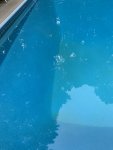 5F91290F-1AC1-4303-9313-F2F962F091BA.jpeg360.9 KB · Views: 4
5F91290F-1AC1-4303-9313-F2F962F091BA.jpeg360.9 KB · Views: 4 -
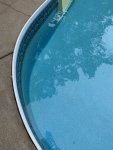 FBF3C455-6BF4-467E-B034-F72B87BCA3D1.jpeg578.4 KB · Views: 4
FBF3C455-6BF4-467E-B034-F72B87BCA3D1.jpeg578.4 KB · Views: 4 -
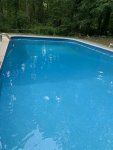 939E2DD2-D3DF-4F8B-BAD4-246DFE6EA724.jpeg468.9 KB · Views: 4
939E2DD2-D3DF-4F8B-BAD4-246DFE6EA724.jpeg468.9 KB · Views: 4 -
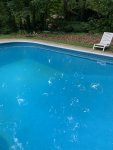 A40A0608-4274-4110-99BB-A607CB825171.jpeg434 KB · Views: 4
A40A0608-4274-4110-99BB-A607CB825171.jpeg434 KB · Views: 4 -
 729A82F4-B604-4EA9-846A-30C6F9B1B35B.jpeg566.2 KB · Views: 4
729A82F4-B604-4EA9-846A-30C6F9B1B35B.jpeg566.2 KB · Views: 4
Hello did your yellow stain went away for good? I also live in Atlanta and first time pool owner. I too have yellow staining at some spots on my pool liner. I am familiar with tannins , a pigment that cause water to turn brown (in South GA). I have a lot of trees on my property. When i bought the house in Dec last year the yard was completely covered with thick layers of leaves.
When we opened the pool in early May it took a week of vacuuming (i used robotic cleaner) to vacuum all the leaves and sand from the pool. Now there are stains on some spots of the liner. I am thinking it could be that the chemicals the previous owner used bleached the liner because the stain is concentrated at one section in the deep end and also the slope. And also maybe due to decayed leaves and sand. Here are some pics.
This thread has over 90 posts on this issue which you can read, but the bottom line, is that regardless of what I have tried, the stains go away and come back. Based on what I have learned, you can try this - Do your stains go away when brushed? If yes, then they are likely organic like an algae, if not, then take some vitamin c and rub it in the stain, if it goes away, then you likely have some type of metal staining. For me, it was most likely caused by iron. There is a treatment you can try which uses Ascorbic Acid (vitamin c), and a metal sequestrant, but this is really just a band aid, and required monthly maintenance doses of the sequestrant to keep the iron suspended in the water so it doesn't stain, however in my case, I can't seem to get the sequestrant to last longer than 5 days. Here is the info on the AA treatment...
Ascorbic Acid Treatment - Further Reading
The mystery continues...on Sunday my phosphates were 2700, so after Joyful’s advice, I added 32oz SeaKlear which was more than enough. Pool clouded up for about 2 days and I just left pool store expecting the level to be around zero, and they actually jumped up to 3886! They even ran the test twice.
- May 23, 2015
- 25,708
- Pool Size
- 16000
- Surface
- Plaster
- Chlorine
- Salt Water Generator
- SWG Type
- Pentair Intellichlor IC-60
The mystery continues...on Sunday my phosphates were 2700, so after Joyful’s advice, I added 32oz SeaKlear which was more than enough. Pool clouded up for about 2 days and I just left pool store expecting the level to be around zero, and they actually jumped up to 3886! They even ran the test twice.
Did your pool ever clear up?
What type of equipment do they have that can measure phosphate to that level of precision?and they actually jumped up to 3886
Don't rely too much on the seemingly exact numbers. The reliability and accuracy of the tests is not that good.
Thread Status
Hello , This thread has been inactive for over 60 days. New postings here are unlikely to be seen or responded to by other members. For better visibility, consider Starting A New Thread.

